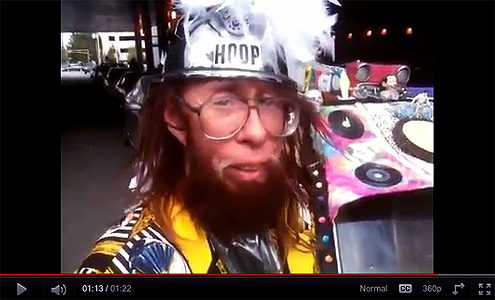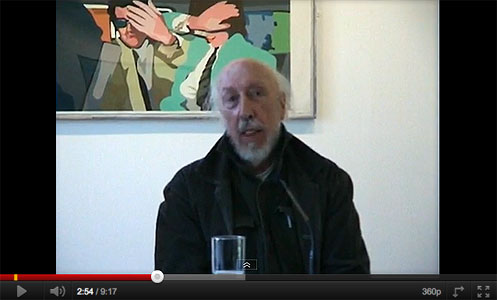November 2011
Andy Warhol's design for the Tacoma Dome in Washington
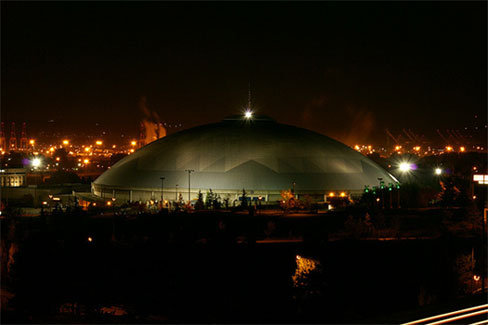
Tacoma Dome (Photo: Rob Green/Flickr)
On January 26, 1982 Andy Warhol submitted a design for the Tacoma Dome in Washington. On behalf of Warhol, Vincent Fremont wrote, "We have also included an acetate of the flower Andy would like to see on the dome. We are sorry this is being submitted at the last minute but Andy’s schedule has been incredibly busy.”
The committee deciding on the design for the dome rejected Warhol's design but the city retained the artwork and the two designs submitted by Warhol have been valued at $70.000. The city's art administrator Amy McBride has said that she would love to see Warhol's flower on the dome, which would be an "amazing gateway to the city."
Peter Callaghan from the local newspaper The News Tribune has written an article supporting the use of Warhol's design here.
Andy Warhol Authentication Board to close in 2012
The Andy Warhol Foundation for the Visual Arts has announced that the Authentication Board will be closing in 2012. The Foundation has issued the following statement:
A STATEMENT FROM THE BOARD OF DIRECTORS OF THE ANDY WARHOL FOUNDATION FOR THE VISUAL ARTS October 19, 2011
For Immediate Release
The Board of Directors of The Andy Warhol Foundation for the Visual Arts, Inc. announced today that the Foundation will dissolve the Andy Warhol Art Authentication Board, Inc. in early 2012. The Foundation’s decision to dissolve the Authentication Board was informed by a strategic review of the Foundation’s core programs and reflects the Foundation’s intent to maximize its grant-making and other charitable activities in support of the visual arts.The Directors further expressed their gratitude and appreciation for the exemplary work and expertise provided by members of the Authentication Board over the past 16 years. The Authentication Board will honor all requests for review received prior to October 19, 2011; but will no longer accept requests for review after that date.
At a time of critical and increasing need for support, the Foundation remains strongly dedicated to its primary charitable mission: that of advancing the visual arts. As a leading grant-maker in the field, the Foundation funds a wide range of museum exhibitions; curatorial research; innovative arts programming by scores of non-profit organizations; arts writing; and individual artist projects through its support of Creative Capital. The Foundation is also engaged more generally in efforts to preserve and protect to the fullest extent all rights of artistic expression. In addition, the Foundation advances the scholarship and understanding of Andy Warhol’s own work through research activities, the publication of the Catalogues Raisonné and by its continued funding and support of The Andy Warhol Museum.
The Foundation’s broad goal is thus to continue to promote greater public understanding and appreciation of the visual arts and the vital contribution that artists and artistic expression make to building and sustaining a more creative and engaged society.
False claims made re: Pietro Psaier and the head of the Warhol Foundation
The people behind the "Pietro Psaier" saga are at it again. In 2008, the UK auctioneer, John Nicholson, whose auction house has been featured on TV shows such as Celebrity Cash in the Attic, claimed that he had sold 2,000 works by an artist named Pietro Psaier who had collaborated on "joint works" of art with Andy Warhol. (See Daily Mail.)
It was later discovered that a known art forger, John Fairchild and his daughter, Nadia Fairchild and her husband (calling himself "Peter Psaier") had started a company called Factory Additions in Los Angeles and Fairchild was selling Psaier paintings through auction houses in London, often accompanied by a Factory Additions certificate or stamped with "Factory Additions." No birth certificate has ever been produced for Psaier. (See here.)
Now, comments have been posted on the About.com page for Pietro Psaier by someone calling himself "Neil" who claims that "Warhol Foundation current President [Joel Wachs] was a Los Angeles Councilman along with Los Angeles Council Supervisor Dean Dana and Councilman Art Torres, who openly promoted the Fairchild Estate in Malibu, California..."
(See comment no. 159 here.)
This was John Fairchild's Malibu estate:
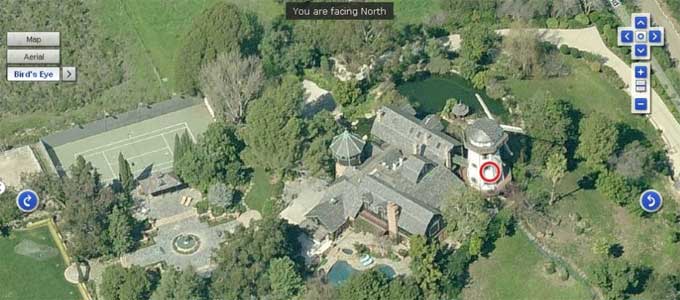
Fairchild had been imprisoned in November 1988 for obtaining a £150,000 mortgage by deception. In 1990, he and his daughter were put on trial for art fraud but by the time of the trial Fairchild had escaped to California, leaving his daughter Nadia to face the charges.
The comment by "Neil" on the About.com site is a blatant attempt to imply that Mr. Wachs somehow endorsed Fairchild even though Mr. Wachs has never endorsed Mr. Fairchild's activities or the alleged "joint works" by Pietro Psaier and Andy Warhol. When asked by the New York Post in 2008 about Pietro Psaier, Wachs said that no one at the Warhol Foundation had ever heard of him.
"Neil" also claims that "Stephen Bruce [of Serendipity fame]...was a major wholesale buyer for Fairchild’s Tiffany style belt buckles and visited Fairchild’s North London Factory in the early 70’s." There is a website devoted to Fairchild's belt buckles here. A warning about the belt buckles has also been issued on Ebay here.
Additional information about "Pietro Psaier" can be found here.
Good-bye Hoop
Hoop being interviewed for Harrod Blank's film Automorphosis (2009) here
Hoop of Hoopmobile fame died on Thursday, 22 September 2011 of cancer. In addition to creating his art autos, he was also very active on the Warhol party circuit and often helped his friend Baird Jones promote his events prior to Jones' death in 2008. Hoop first contacted me in 2009, just before the Midsummer Madness party at the Gershwin Hotel. He began submitting photos of the Warhol events he attended and I've been using them on the site ever since. As we got to know each other he gave me a bit of his background. It turned out that he had English connections.
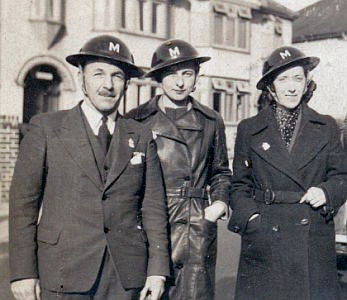
Hoop: "My Aunt Bessie on right as a firewatcher in England during WW2 bombing."
Hoop:
"Three of my grandparents came from the Bristol area in England - My father's mother from Wales - They came to this country around 1910. My grandparents had many brothers and sisters which all stayed in the UK. Both sets of grandparents came and lived in the New York area. In the 1930s my father's mother heard of a nice English family in New Jersey. When they went to visit them, my father met my mother. They were married and had a son in '42. Then my father enlisted and went off to Europe in World War 2. When he came back in '46 I became one of the first of the "Baby Boomer" generation. And that's the origin of HOOP."
Hoop remained positive throughout his fight with cancer. He began treatment in December 2010: "Started radiation treatments on my head this week - Hey - but still out partyin' at night - And building a new Time Machine Jr. Hoopmobile." A week later he wrote, "...the radiation treatments are no big deal for me - Go in - lay down on a table - they buzz my head - feel not a thing - only takes a few minutes and I'm outa there - and it's workin' - Last week my head was swelled up and had double vision with some pain etc - A couple treatments - my vision is back - pain gone - swelling went away - amazing. A bunch more treatments and hopefully it'll all be gone again - Guess a good attitude helps too."
Despite the radiation treatments, Hoop continued to send me photos of the Warhol crowd until he became too ill to go to the events. In August 2011 he was unable to make it to the Andy Warhol birthday party at the Gershwin - "tired from goin' through chemo - so i couldn't make it" - but he still sent me photos that a friend of his had taken which I featured on the site.
Hoop will be missed greatly. His "good attitude" in the midst of a social scene that can sometimes be full of infighting and negativity was always welcome. He leaves behind a legacy of art cars that were highly original - like him. Rest in peace Hoop.
Photos of Hoop, his cars and his friends can be found on his blog page here.
The Whitney announces the team behind the second volume of the film catalogue raisonné
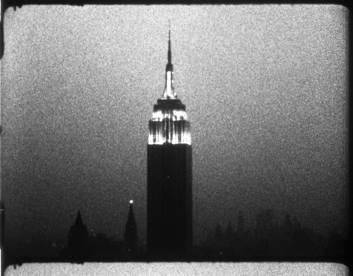
The Whitney has announced the team behind the second volume of the film catalogue raisonné. The first volume, devoted to Warhol's Screen Tests was authored by Callie Angell and published in 2006. Getting the facts right in the world of Warhol can be a daunting task and Callie was instrumental in clearing up much of the misinformation that is published about Warhol. When you read something by Callie you can be sure that it is accurate and backed up by documentary evidence. Her Screen Tests book is a veritable 'who's who' of the '60s and is an essential research source for anyone writing on Warhol's films or about the era in general. Sadly, she died last year before she was able to complete the second volume of the cat. rais.
The new team who will be working on the second volume consists of Callie's assistant Claire Henry as well as John G. Hanhardt, Bill Horrigan and Bruce Jenkins.
Full details on the press release here.
New Joe Dallesandro book to be published

A new book about Warhol star Joe Dallesandro is currently going to print. The book is a complete overhaul of the out-of-print book, Little Joe, Superstar. The new edition, titled JOE DALLESANDRO: Warhol Superstar, Underground Film Icon, Actor, will include new interview material and more than 150 images, the vast majority of which were not in the first book. The text of the original edition has been extensively revised and all of Joe's films re-visited. The author of the book is Michael Ferguson who also wrote the first edition of the book and is the site author of the official Joe Dallesandro website here.
Cocaine Cowboys in Low Budget Hell
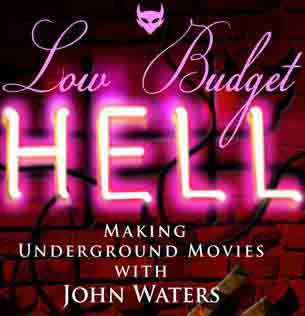
Robert Maier's account of working as the soundman of several John Waters' films, Low Budget Hell: Making Underground Movies with John Waters, is out now. In addition to working with Waters, Maier was also the soundman on Cocaine Cowboys, filmed on Andy Warhol's Montauk estate, which featured a cameo appearance by Warhol.
From Low Budget Hell: Making Underground Movies with John Waters:
"One shoot day [on Andy Warhol's Montauk estate] we ran into legal trouble. We had set up the camera, a few lights, and sound for a quiet dialogue scene on the broad lawn in back of the main house that faced the beautiful rocky beach. In the middle of a take, a group of strangers walked up... Ulli [Lommel] shouted out in his crisp academic English, flavoured by a thick German accent, 'Excuse me, but ve are chooting a movie here, und you've interrupted a scene.'
... 'this isn't funny,' the guy said, and pulled out a wallet with a big gold badge on it. He then pulled out a big black pistol from a holster behind his back and shouted, 'We're Drug Enforcement Adminstration. Everybody sit down where you are, drop everything, and put your hands on the ground.'
... I sat and didn't budge. I'd never had a gun pointed at me before. Tom [Sullivan] said they would search the place, and looking through the house's open doors I saw the front drive filling up with cop cars. I thought, oh great, this movie is all a big front for a drug smuggling operation, and I'll end up going to jail."
Brand X at the Hammer on October 11, 2011
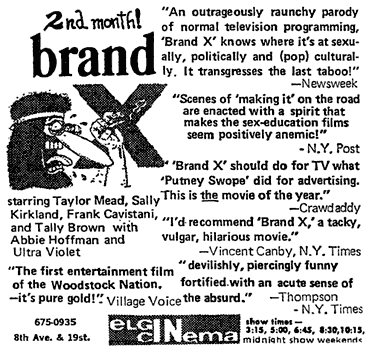
The Wynn [aka Win] Chamberlain film, Brand X, will be shown at the Hammer Museum in Los Angeles on October 11, 2011. Details here.
The film also has a new website that includes notices of future screenings at: Brand X.
The cast includes Warhol stars Taylor Mead, Sally Kirkland, Frank Cavistani, Tally Brown and Ultra Violet, as well as playwright Sam Shepard.
From Sam Sheppard's website - on Brand X:
"The film follows the on-and off-air shenanigans of Wally Right, the manic head of a television station. It takes on President Nixon, the Vietnam War, sex, drugs, technology and advertising, alternating between vignettes riffing on TV programming — an exercise show, a soap opera, a financial report — and Dadaist commercials like one for 'Food,' in which the film’s cinematographer, John Harnish, is seen sitting with a naked blond woman at a table covered with fruit. 'Eat more, think less,' he quips to the camera. Abbie Hoffman plays a corrupt cop who bathes in a tub full of money; Taylor Mead portrays an indignant American president holding a news conference; and Ultra Violet gives an off-key performance on 'The Tomorrow Show.'"
R.I.P. Richard Hamilton
Richard Hamilton on You Tube (click on image or go to: here)
UK Pop artist Richard Hamilton died on 13 September 2011. A member of the Independent Group, he defined "Pop Art" in 1957 as: Popular (designed for a mass audience), Transient (short-term solution), Expendable (easily forgotten), Low Cost, Mass-Produced, Young (aimed at youth), Witty, Sexy, Gimmicky, Glamorous, Big Business" in a letter to Peter and Alison Smithson. (A discussion on the origination of the term "Pop Art" can be found here.)
Richard Hamilton:
"When I made that list I thought what are the characteristics of what we call pop art, and then I listed them, big business and so on; the record system, Hollywood and all the other things. Then I looked at this list that I had made, which had nothing to do with fine art or anything that I was painting or doing and said, is there anything in this list which is incompatible with fine art? And my answer was no, except for one thing and I said, expendable. Now is fine art expendable? And I thought no; I can't quite stomach that. Everything else, OK, but expendability as a throwaway attitude is not something that can be acceptable as pop art, and I was proved wrong. Warhol, approached art from the point of view of expendability, so I admire him enormously having brought my attention to the fact that I was wrong." (See BBC interview)
Hamilton's students included Mark Lancaster who appeared in Batman Dracula, Couch and a Kiss film with Gerard Malanga.
Mark Lancaster:
"Richard Hamilton was not at all well known as an artist at that time, but had gone to Pasadena the previous year - his first trip to the US - to see the Duchamp exhibition which Walter Hopps had organized, the first big Duchamp exhibition anywhere I think. Marcel Duchamp and his wife were there, and Andy must have been having a show in LA - at any rate they met at a party.
Richard told me when he came back that if I went to New York I should call him [Warhol]. I only knew Warhol then from a couple of reproductions in magazines, and I think a photograph of him in Life or something, with some paintings in a Bonwit Teller window. He was still thought of as less "important" by the critics than say Lichtenstein. Warhol wasn't included in a big Painting 1954 to 64 show that was at the Tate in Summer of '64, even though Jim Dine, for example, was.
So I had little sense of Andy in any particular way. I was nervous about calling him, but I had at that point I think been in NY for three days without speaking to anybody. He was so friendly when he called me back, and invited me right away to come by the Factory, but it was walking into that incredible place that I immediately thought, something like, "Well, this is it; this is absolutely the most exciting place I have ever been and there is something extraordinary going on here." (Full interview here.)
